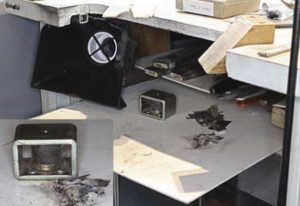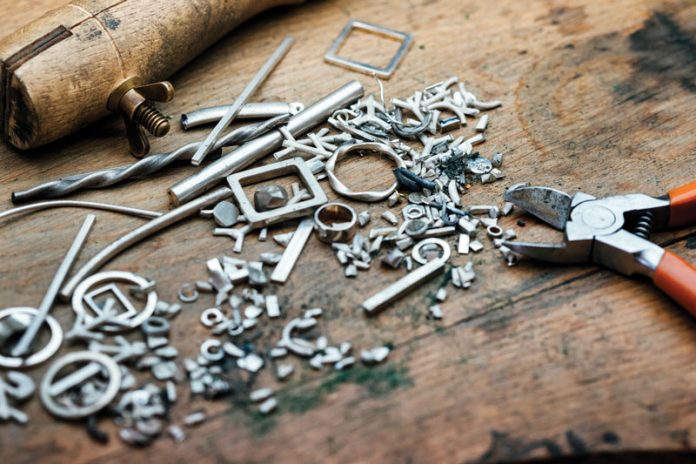
Saving precious metal scrap to use again helps save money and natural resources. Here are some simple steps you can take to reclaim the maximum amount of scrap in your studio.
Mining Natural Resources
Precious metals and gemstones must be mined from the earth. At least 50% of newly mined gold is used in jewelry. As jewelers, we depend on mining to obtain new materials. Mining methods and their impacts vary greatly. In each case, there are challenges to overcome, as well as opportunities to help people.
Challenges related to social issues include the impacts on local communities, human rights, child labor, and health and safety for miners. Environmental issues include the use of toxic chemicals, loss of agriculture or wildlife, deforestation and soil erosion.
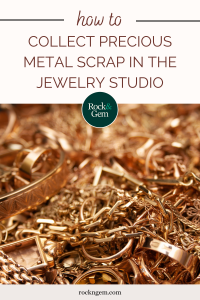
Mining can also provide valuable opportunities when managed properly, such as honest work for a great number of people, benefits for the country of origin and delivery of quality materials to the jewelry industry.
As a jeweler, you have the power to make a difference by capturing as much precious metal scrap as possible and keeping it in the system, which benefits both the planet and your bottom line.
How to Collect Bench Scrap
Review your jewelry designs, planning and operations to reduce metal loss during fabrication, casting and cleanup. Be sure you have implemented every possible practice for capturing precious metals from the time they enter to the time they leave the workshop. Precious metal particles can be found almost anywhere dust particles are found.
Separate Your Metals by Collecting in Paper
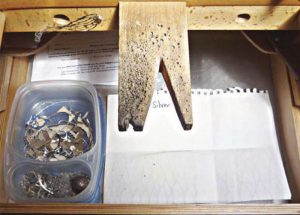
For jewelers who work with various precious metals, a simple way to collect your bench scrap while keeping your karats and alloys separate is to line your bench pan with a large piece of paper, folded like a book with a crease down the center. Before switching to a different metal, sweep the metal dust and scraps from the paper into the collection container for the appropriate karat or alloy.
Keep a clearly marked piece of paper for each alloy near your bench to save time. Before beginning to work with a different alloy, lay the paper marked for that alloy in your bench pan. Careful use of this method will help increase purity in your scrap collection. If you diligently keep your alloy scraps separate, Alan Revere, founder and director of the Revere Academy of Jewelry Arts, suggests that scraps large enough to be picked up with tweezers can be recycled in-house by casting them into an ingot.
Carboard Box Alternative
An alternative to the paper pan liner is to use a shallow cardboard box for each alloy or karat being collected. You can use either collection system to prevent metals and other materials that should not be refined from entering your scrap.
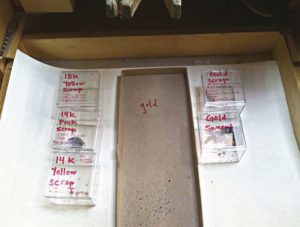
LUANA COONEN PHOTO
Use a different piece of paper or cardboard to collect nonprecious metals, stone, plastics and other materials that would contaminate your scrap. Benjamin Manning, of Utopian Creations in Adelaide, Australia, uses hard, flat, recycled wooden trays that slide in and out on runners for catching bench scrap.
Remove Iron & Steel
Before sending scrap in for refining, use a strong magnet to remove all iron and steel [and remove steel parts from watches or other mechanisms]; Manning suggests using an old speaker magnet to remove steel. During refining, it takes more energy to separate the iron from the precious metal, creating a greater impact on the environment and lowering your returns.
Recover From Every Location
Linda Weiss, of Linda Weiss Designs in Santa Rosa, California, recovers precious metal dust from her broken saw blades, as well. She puts the broken blades (collected over about a year) in a jar with water, which she places in the ultrasonic to vibrate off the precious metals. Then, she evaporates the water on top of her kiln. She states, “since this usually is a random mix of metal, I weigh and pack it separately from the known quantities.”
Though she does this because she doesn’t like to waste, she states, “even if I recover two to three dwt, at current metal prices, I think the time spent is also cost-effective.”
Collecting Scrap in the Studio As Marc Choyt, of Reflective Images in Santa Fe, New Mexico, states, “It’s not just [at] the bench. It is every speck of dusk in our work area.” Choyt says, “I accumulate all of this over a few years and send it to our refiner … and they send me a big fat check.”
Use an Extraction System
Both Manning and Weiss use Quatro Air Technologies extraction systems at each bench tray to capture polishing dust. Manning used parts from a plumbing store to modify the debris capture area for the Quatro.
James Binnion, of James Binnion Metal Arts in Bellingham, Washington, recommends a fully enclosed Quatro Pro polishing hood for capturing the maximum amount of precious metal dust at the polishing machine.
Using natural rubber to cover the studio floor to capture materials that fall to the floor and makes it easier to see and recover everything. For workshops with carpeting, refiners suggest investing in a vacuum with a water filter. Not only will it help eliminate dust, but the fast agitation of the machine also helps to separate polishing compounds from precious metal particles, and the water filtration system allows the heavier particles to settle to the bottom.
Reclaim Precious Metal from Sludge
Reclaim precious metal particles from the sludge that collects in water vacuums, sink traps, tumblers, and ultrasonic cleaners. Especially for vacuum sludge, let the heavier materials settle to the bottom of the receptacle and remove the lightest material from the top. Then, allow the liquid from the sludge to evaporate.
Many refiners will calculate your total returns based on the incoming weight of your package. Therefore, it is in your best interest to allow sludge that contains precious metal particles to evaporate before sending it in for refining. You can promote rapid drying by passing sludge through a coffee filter.
How to Choose a Refiner
It is important to do your research before selecting a refiner. Refining is not an industry that is FDIC insured. For the security of your business, select a company that has a track record you can trust. For the health of both the planet and our industry, verify that your refiner has earned a third-party certification of the safety, environmental responsibility and transparency of their operations. There are two most common types of certification for refiners.
SCS Global Services offers a Responsible Source for Precious Metals certification that verifies precious metals are derived from recycled sources and are conflict-free. Standards also ensure labor protections, improved sourcing strategies, environmental practices, and requirements for continuing to improve environmental performance over time.
The Responsible Jewellery Council (RJC) certification programs are designed to support responsible business practices in the jewelry supply chain. Currently, two certifications are available. RJC’s Code of Practices for RJC Member Certification addresses business ethics, human rights, and social and environmental performance. RJC Chain-of-Custody Certification is a voluntary standard, designed to build on the Code of Practices and focus on the flow of precious metals through the supply chain.
HOW TO CAPTURE PRECIOUS METALS IN THE STUDIO• Separate metal scrap • Use a bench tray, apron, folded paper, or shallow cardboard box to collect filings and small scraps • Before washing, wipe hands on reusable cloth or paper towel to collect fine particles • Install a sink trap • Use floor mats or carpet near doors to trap precious metal dust before it leaves the studio • Use a fully enclosed hood to capture polishing dust • Sweep or vacuum regularly with a dedicated vacuum
ITEMS TO COLLECT FOR REFINING• Floor sweeps • Rags, paper/cloth towels, gloves, dust masks, aprons and work clothes • Buffs, brushes and emery paper • Sludge from sink trap, ultrasonic cleaner, tumbler and water vacuums • Polishing dust and vacuum bags/filters,w respirator cartridges • Carpets and flooring • Plastic bags and tape that have contained or touched precious metal dust • Anything that has touched precious metals during jewelry manufacture |
This story about how jewelers can save precious metal scrap appeared in Rock & Gem magazine. Click here to subscribe. Story by Christine Dhein.


